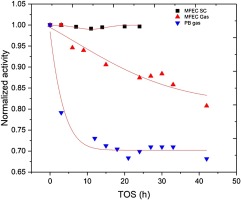Catalysis Today ( IF 5.3 ) Pub Date : 2019-01-22 , DOI: 10.1016/j.cattod.2019.01.031 H.A Choudhury , X. Cheng , S. Afzal , A.V Prakash , B.J Tatarchuk , N.O Elbashir

|
Cobalt-based catalysts have been used to convert H2 rich syngas derived from natural gas by the Fischer-Tropsch synthesis (FTS). Cobalt-based catalysts exhibit several advantages such as low water gas shift (WGS) activity, favorable C5+ selectivities, and high CO conversion. However, higher conversion achieved in conventional cobalt-based packed bed (PB) reactor often leads to catalyst deactivation due to hot-spot formation, and increased methane selectivity. A conventional cobalt-based PB has low thermal conductivity (0.16 W/m.K), which essentially means poor heat transfer management across the reactor bed. Novel catalyst configuration such as microfibrous entrapped catalyst (MFEC) offers better heat transfer across the bed due to their higher thermal conductivity (9.05 W/m.K). This study reports the performance of FTS over a cobalt-based catalyst in two different types of reactors, the MFEC and the PB utilizing both conventional gas phase (GP) and supercritical fluid (SCF) as reaction media. The focus of the study to investigate the catalyst deactivation mechanism over relatively short time on stream (i.e., 30–40 h). The MFEC bed under the SCF conditions showed very stable performance while both the PB and the MFEC in GP showed steady deactivation profiles. The 1st order steady state activity () for the MFEC-SCF run was determined to be 0.99 compared to MFEC-GP run of 0.83. The value for the PB-GP run was 0.61 indicating a higher deactivation compared to MFEC bed run. Chemisorption and TEM imaging revealed a negligible deactivation of MFEC-SCF catalyst as indicated by a slight growth of crystallite size to ˜9.5 nm from ˜8 nm. SEM imaging and TGA study of the spent catalysts revealed wax deposition being a significant contributor to deactivation in GP-FTS but not in an SCF-FTS. XRD and XPS analysis of the spent catalyst indicated a higher degree of oxidation in GP-FTS as opposed to SCF-FTS.
中文翻译:

了解超临界流体费-托合成中微纤维夹带钴催化剂的失活过程
钴基催化剂已用于转化H 2费-托合成(FTS)从天然气中提取的丰富合成气。钴基催化剂具有许多优势,例如低水煤气变换(WGS)活性,有利的C5 +选择性和高的CO转化率。然而,在常规的钴基填充床(PB)反应器中实现的较高转化率通常由于形成热点而导致催化剂失活,并提高了甲烷的选择性。常规的钴基PB具有较低的热导率(0.16 W / mK),这实质上意味着整个反应器床的传热管理不佳。诸如微纤维截留催化剂(MFEC)之类的新型催化剂结构因其较高的热导率(9.05 W / mK)提供了更好的整个床层传热。这项研究报告了在两种不同类型的反应堆中,FTS在钴基催化剂上的性能,MFEC和PB使用常规气相(GP)和超临界流体(SCF)作为反应介质。研究的重点是在相对短的时间内(即30–40小时)研究催化剂的失活机理。SCF条件下的MFEC床表现出非常稳定的性能,而GP中的PB和MFEC均表现出稳定的失活曲线。1st阶稳态活动()的MFEC-SCF运行确定为0.99,而MFEC-GP运行的确定为0.83。这PB-GP运行的数值为0.61,这表明与MFEC床运行相比,更高的失活率。化学吸附和TEM成像显示MFEC-SCF催化剂的失活可以忽略不计,这是由微晶尺寸从约8 nm轻微增长到约9.5 nm所表明的。SEM成像和废催化剂的TGA研究表明,蜡沉积是GP-FTS失活的重要原因,而SCF-FTS却不。用过的催化剂的XRD和XPS分析表明,与SCF-FTS相比,GP-FTS中的氧化程度更高。


























 京公网安备 11010802027423号
京公网安备 11010802027423号